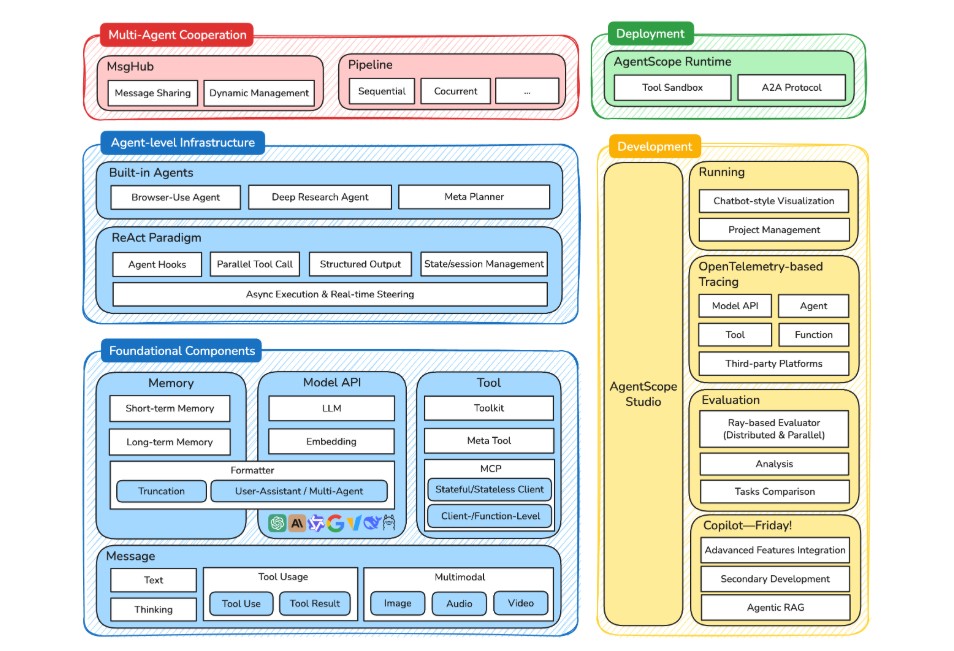Artificial Intelligence is no longer confined to single-task assistants- it’s evolving into ecosystems of intelligent agents that collaborate, reason and adapt. This shift has given rise to powerful frameworks that help developers build complex, multi-agent applications with greater transparency and control.
One such breakthrough is AgentScope, an open-source framework designed specifically for agent-oriented programming. In this blog, we’ll explore how it empowers developers to build scalable, multi-agent systems what makes it unique and why it’s becoming a go-to choice for AI-driven applications.

What is AgentScope?
It is a Python-based framework designed to help developers build LLM-powered applications with a strong focus on transparency, flexibility, and control. Unlike traditional frameworks that hide key components behind layers of abstraction, it ensures that prompt engineering, agent orchestration, tool integration and workflow management remain fully visible and customizable.
The framework is built around the principle of agent-oriented programming (AOP). This means developers can treat AI agents as modular entities, connect them together in workflows and manage their interactions in a clear and structured way. With AgentScope, you can create single-agent or multi-agent systems, integrate third-party tools, manage long-term memory and even evaluate agents in distributed environments.
Why AgentScope Stands Out ?
It introduces several unique features that make it a standout option among AI development frameworks:
- Transparency First – All aspects of agent design, from prompts to tool calls, are explicit and controllable. Developers never have to worry about hidden logic or opaque abstractions.
- Realtime Steering – Native support for real-time interruption and customized handling allows developers to dynamically adjust agent behaviors during execution.
- Multi-Agent Oriented – AgentScope is designed for multi-agent workflows from the ground up. Agents communicate through explicit message-passing, ensuring clarity in complex orchestration tasks.
- Modular LEGO-Style Components – Every element in AgentScope – agents, tools, memory modules, formatters and workflows, is modular and interchangeable.
- Model Agnostic – Developers can build once and run across multiple models, including Qwen, GPT, LLaMA and more.
- High Customizability – Whether you want to add new tools, connect external APIs or design custom workflows, AgentScope encourages extensive customization.
Key Features
1. Agent-Oriented Programming
It provides a foundation for agentic workflows, allowing developers to create and manage agents with explicit message-passing. This makes debugging, scaling and extending systems far easier than with opaque agent frameworks.
2. Multi-Agent Conversations
With features like MsgHub and pipeline management, developers can create multi-agent conversations where multiple agents collaborate, debate or handle tasks in parallel. Agents can be dynamically added or removed from conversations, enabling highly flexible workflows.
3. Realtime Steering
In traditional AI frameworks, once an agent starts processing, interrupting or modifying its flow is difficult. I solves this with realtime steering, enabling interruptions, adjustments and resumptions without losing state.
4. Tool and MCP Integration
AgentScope integrates with the Model Context Protocol (MCP) to allow seamless interaction with external tools. Developers can treat MCP tools as callable functions, pass them to agents or even wrap them into more complex pipelines.
5. Long-Term Memory and State Management
Unlike stateless LLM frameworks, AgentScope supports long-term memory control and automatic state management across sessions. Developers can choose between in-memory storage or database-backed memory for persistence.
6. Tracing and Evaluation
AgentScope integrates with OpenTelemetry-based tracing, allowing developers to monitor agent behaviors and performance. It also supports distributed and parallel evaluation, making it easier to test and benchmark multi-agent systems.
7. Planning Module
With its newly introduced Plan module, developers can design ReAct-based long-term planning or even manually specify plans for agents. This helps in managing workflows that require structured decision-making over multiple steps.
Getting Started with AgentScope
Setting up AgentScope is simple. Developers can install it either from PyPI or directly from the source code.
Install via PyPI:
pip install agentscope
Install from source:
git clone -b main https://github.com/agentscope-ai/agentscope.git
cd agentscope
pip install -e .
Once installed, you can create your first agent in just a few lines of code. Here’s a simple “Hello AgentScope” example:
from agentscope.agent import ReActAgent, UserAgent
from agentscope.model import DashScopeChatModel
from agentscope.memory import InMemoryMemory
from agentscope.tool import Toolkit, execute_python_code
import os, asyncio
async def main():
toolkit = Toolkit()
toolkit.register_tool_function(execute_python_code)
agent = ReActAgent(
name="Friday",
sys_prompt="You're a helpful assistant named Friday.",
model=DashScopeChatModel(
model_name="qwen-max",
api_key=os.environ["DASHSCOPE_API_KEY"],
stream=True,
),
memory=InMemoryMemory(),
toolkit=toolkit,
)
user = UserAgent(name="user")
msg = None
while True:
msg = await agent(msg)
msg = await user(msg)
if msg.get_text_content() == "exit":
break
asyncio.run(main())
This demonstrates how easy it is to define an agent, assign it a prompt, connect it with a model,] and enable tool execution.
Use Cases of AgentScope
It’s modularity and flexibility make it applicable across multiple industries and use cases:
- Customer Support Automation – Deploy multi-agent systems to handle complex customer queries by breaking them into smaller tasks.
- Research Assistance – Agents can collaborate to search, analyze, and summarize large volumes of data.
- Developer Tools – Automate debugging, code generation, and terminal operations.
- Business Workflows – Streamline document creation, data processing, and report generation with interconnected agents.
- Education & Training – Create interactive teaching assistants capable of multi-round conversations and adaptive learning paths.
Conclusion
AgentScope is more than just another AI framework- it represents a new era of agent-oriented programming where developers can fully control, customize and scale multi-agent systems. With its modular design, transparent workflows and support for real-time steering, it offers the perfect balance between simplicity and power.
Whether you’re experimenting with LLMs, building collaborative agent applications, or deploying enterprise-grade AI systems, it equips you with the tools to succeed. As the demand for intelligent, multi-agent solutions continues to grow, AgentScope stands out as a future-ready platform shaping the way developers build with AI.
Related Reads
- Eigent: The World’s First Multi-Agent Workforce for Next-Level Productivity
- Pen and Paper Exercises in Machine Learning: A Free Resource to Master ML Fundamentals
- 7 AI Books That Can Teach You More Than a $200K Master’s Degree
- 10 GitHub Repositories to Build a Career in AI Engineering
- Asteroid Collision in Python – LeetCode75 Explained

5 thoughts on “AgentScope: A Powerful Developer-Centric Framework for Building Agentic Applications”